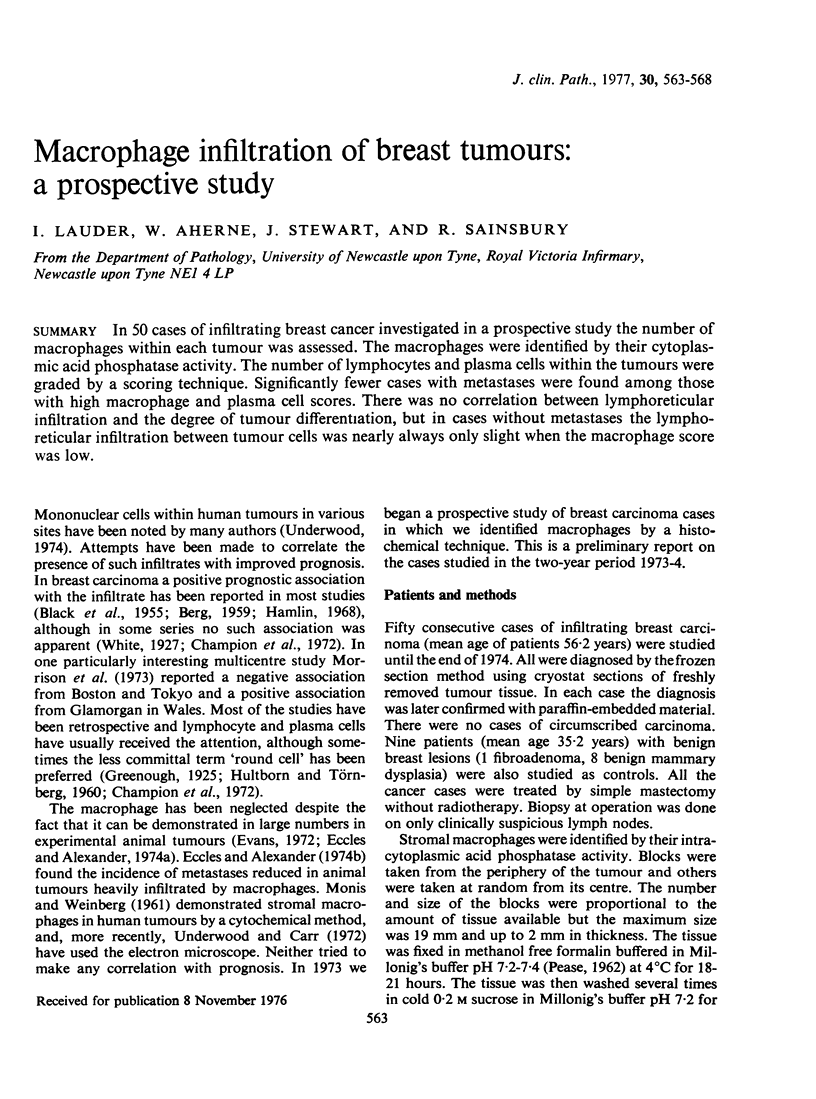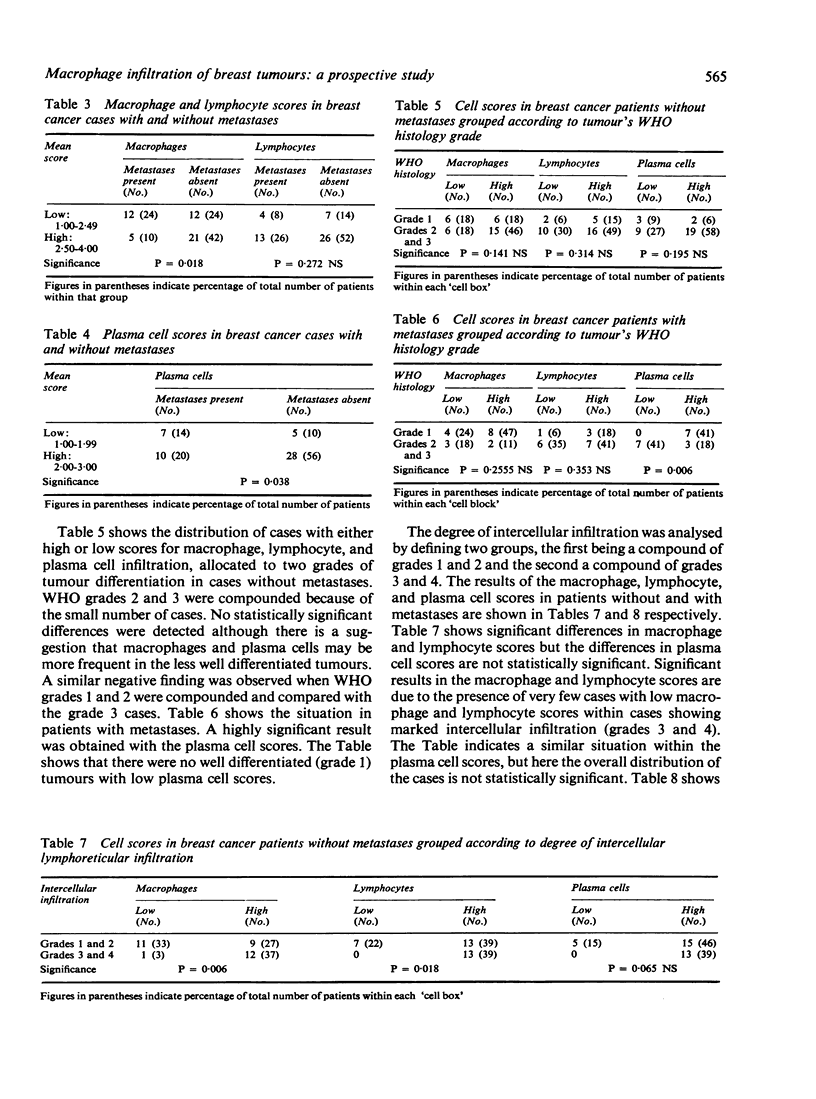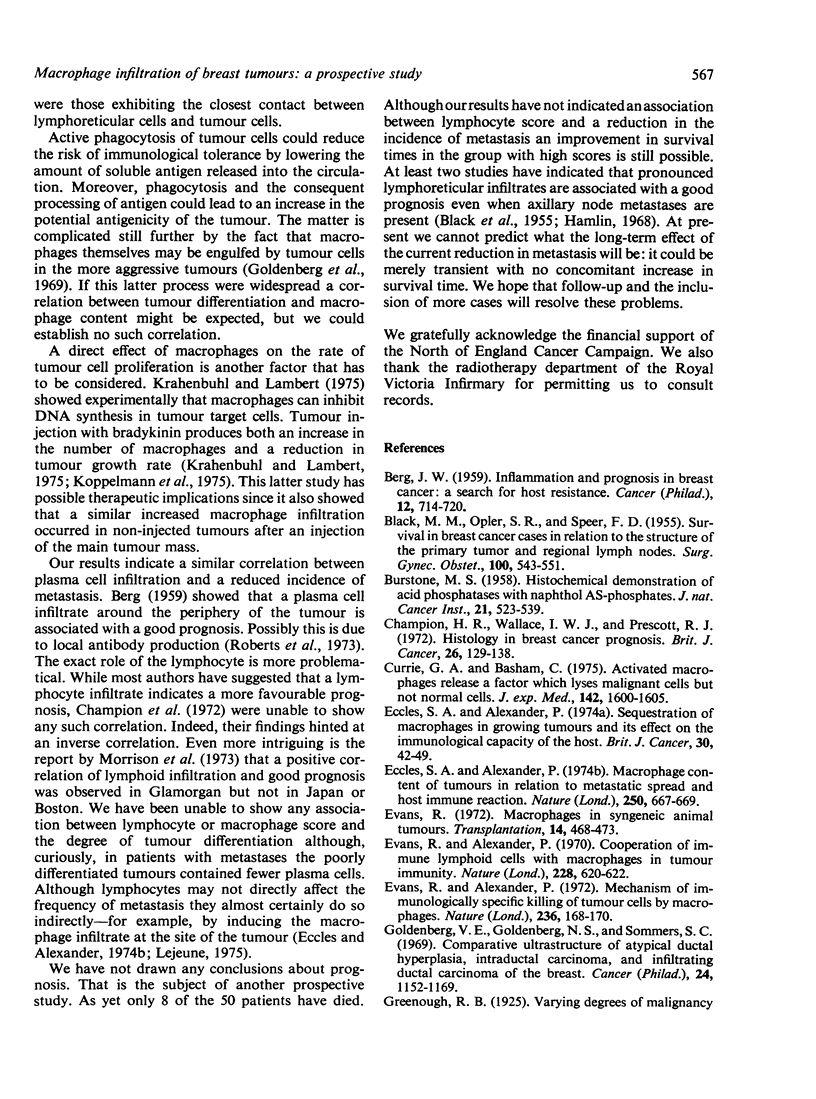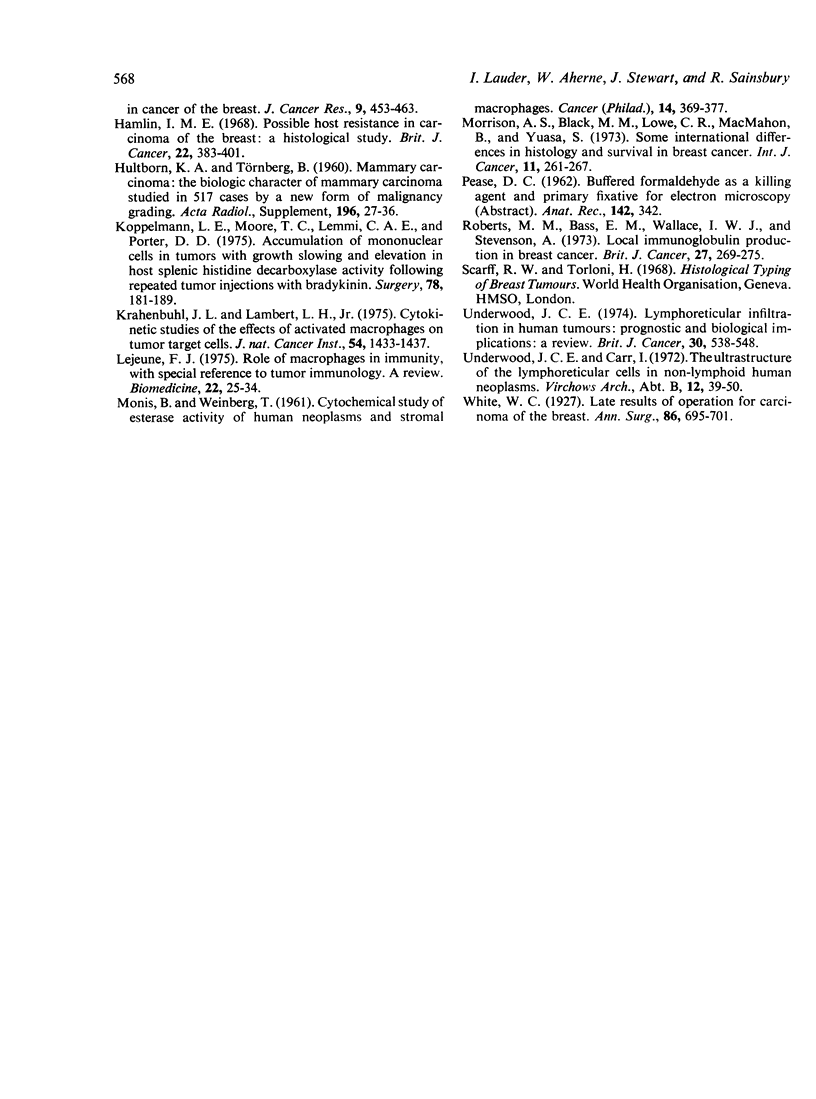Abstract
In 50 cases of infiltrating breast cancer investigated in a prospective study the number of macrophages within each tumour was assessed. The macrophages were identified by their cytoplasmic acid phosphatase activity. The number of lymphocytes and plasma cells within the tumours were graded by a scoring technique. Significantly fewer cases with metastases were found among those with high macrophage and plasma cell scores. There was no correlation between lymphoreticular infiltration and the degree of tumour differentiation, but in cases without metastases the lymphoreticular infiltration between tumour cells was nearly always only slight when the macrophage score was low.
Full text
PDF





Selected References
These references are in PubMed. This may not be the complete list of references from this article.
- BERG J. W. Inflammation and prognosis in breast cancer; a search for host resistance. Cancer. 1959 Jul-Aug;12(4):714–720. doi: 10.1002/1097-0142(195907/08)12:4<714::aid-cncr2820120414>3.0.co;2-b. [DOI] [PubMed] [Google Scholar]
- BLACK M. M., OPLER S. R., SPEER F. D. Survival in breast cancer cases in relation to the structure of the primary tumor and regional lymph nodes. Surg Gynecol Obstet. 1955 May;100(5):543–551. [PubMed] [Google Scholar]
- BURSTONE M. S. Histochemical demonstration of acid phosphatases with naphthol AS-phosphates. J Natl Cancer Inst. 1958 Sep;21(3):523–539. [PubMed] [Google Scholar]
- Champion H. R., Wallace I. W., Prescott R. J. Histology in breast cancer prognosis. Br J Cancer. 1972 Apr;26(2):129–138. doi: 10.1038/bjc.1972.19. [DOI] [PMC free article] [PubMed] [Google Scholar]
- Currie G. A., Basham C. Activated macrophages release a factor which lyses malignant cells but not normal cells. J Exp Med. 1975 Dec 1;142(6):1600–1605. doi: 10.1084/jem.142.6.1600. [DOI] [PMC free article] [PubMed] [Google Scholar]
- Eccles S. A., Alexander P. Macrophage content of tumours in relation to metastatic spread and host immune reaction. Nature. 1974 Aug 23;250(5468):667–669. doi: 10.1038/250667a0. [DOI] [PubMed] [Google Scholar]
- Evans R., Alexander P. Cooperation of immune lymphoid cells with macrophages in tumour immunity. Nature. 1970 Nov 14;228(5272):620–622. doi: 10.1038/228620a0. [DOI] [PubMed] [Google Scholar]
- Evans R., Alexander P. Mechanism of immunologically specific killing of tumour cells by macrophages. Nature. 1972 Mar 24;236(5343):168–170. doi: 10.1038/236168a0. [DOI] [PubMed] [Google Scholar]
- Evans R. Macrophages in syngeneic animal tumours. Transplantation. 1972 Oct;14(4):468–473. doi: 10.1097/00007890-197210000-00011. [DOI] [PubMed] [Google Scholar]
- Goldenberg V. E., Goldenberg N. S., Sommers S. C. Comparative ultrastructure of atypical ductal hyperplasia, intraductal carcinoma, and infiltrating ductal carcinoma of the breast. Cancer. 1969 Dec;24(6):1152–1169. doi: 10.1002/1097-0142(196912)24:6<1152::aid-cncr2820240614>3.0.co;2-5. [DOI] [PubMed] [Google Scholar]
- Hamlin I. M. Possible host resistance in carcinoma of the breast: a histological study. Br J Cancer. 1968 Sep;22(3):383–401. doi: 10.1038/bjc.1968.47. [DOI] [PMC free article] [PubMed] [Google Scholar]
- Koppelmann L. E., Moore T. C., Lemmi C. A., Porter D. D. Accumulation of mononuclear cells in tumors with growth slowing and elevation in host splenic histidine decarboxylase activity following repeated tumor injections with bradykinin. Surgery. 1975 Aug;78(2):181–189. [PubMed] [Google Scholar]
- Krahenbuhl J. L., Lambert L. H., Jr Cytokinetic studies of the effects of activated macrophages on tumor target cells. J Natl Cancer Inst. 1975 Jun;54(6):1433–1437. doi: 10.1093/jnci/54.6.1433. [DOI] [PubMed] [Google Scholar]
- Lejeune F. J. Role of macrophages in immunity, with special reference to tumour immunology. A review. Biomedicine. 1975 Jan;22(1):25–34. [PubMed] [Google Scholar]
- MONIS B., WEINBERG T. Cytochemical study of esterase activity of human neoplasms and stromal macrophages. Cancer. 1961 Mar-Apr;14:369–377. doi: 10.1002/1097-0142(196103/04)14:2<369::aid-cncr2820140217>3.0.co;2-x. [DOI] [PubMed] [Google Scholar]
- Morrison A. S., Black M. M., Lowe C. R., MacMahon B., Yuasa S. Some international differences in histology and survival in breast cancer. Int J Cancer. 1973 Mar 15;11(2):261–267. doi: 10.1002/ijc.2910110203. [DOI] [PubMed] [Google Scholar]
- Roberts M. M., Bass E. M., Wallace I. W., Stevenson A. Local immunoglobulin production in breast cancer. Br J Cancer. 1973 Apr;27(4):269–275. doi: 10.1038/bjc.1973.33. [DOI] [PMC free article] [PubMed] [Google Scholar]
- Underwood J. C., Carr I. The ultrastructure of the lymphoreticular cells in non-lymphoid human neoplasms. Virchows Arch B Cell Pathol. 1972;12(1):39–50. doi: 10.1007/BF02893984. [DOI] [PubMed] [Google Scholar]
- Underwood J. C. Lymphoreticular infiltration in human tumours: prognostic and biological implications: a review. Br J Cancer. 1974 Dec;30(6):538–548. doi: 10.1038/bjc.1974.233. [DOI] [PMC free article] [PubMed] [Google Scholar]
- White W. C. LATE RESULTS OF OPERATION FOR CARCINOMA OF THE BREAST. Ann Surg. 1927 Nov;86(5):695–701. [PMC free article] [PubMed] [Google Scholar]


